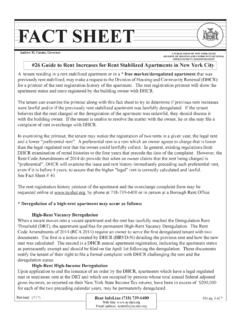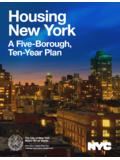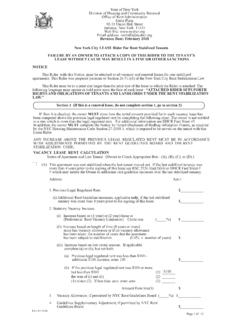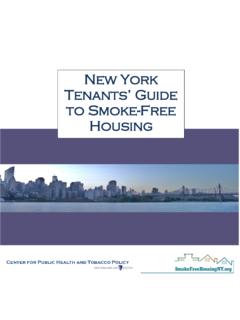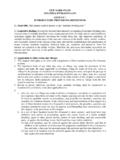Transcription of NEW YORK CITY FIRE DEPARTMENT - City of New York
1 new york city fire DEPARTMENT . 2014 fire CODE. SIGNIFICANT CHANGES. ENACTED BY. LOCAL LAW 148 OF 2013. fire SAFETY DIRECTORS. ASSOCIATION. SOCIETY OF fire PROTECTION. ENGINEERS. January 14, 2014. 2014 new york city fire DEPARTMENT . All rights reserved. FDNY and FDNY logo trademarks of city of new york . 1. CODE REVISION PROCESS AND. 2013 LOCAL LAW. Periodic review and revision of code. Local Law 26 (NYC. Admin Code 29-104) requires that FDNY review new editions of IFC and submit to city Council every 3 years proposed amendments to the fire Code. 2011-2013 fire Code revision process. fire DEPARTMENT Technical Committees reviewed 2006 and 2009 editions of IFC and internal proposed amendments. Proposals reviewed by Advisory Committee of real estate, professional, industry and trade organizations and DEPARTMENT of Buildings, with city Council participation. Amendments enacted by city Council in December 2013, signed by the Mayor on December 30, 2013, and effective March 30, 2014. 2014 new york city fire DEPARTMENT .
2 All rights reserved. FDNY and FDNY logo trademarks of city of new york . 2. 2014 fire CODE SIGNIFICANT CHANGES. ROOFTOP ACCESS. 1. Comprehensively amended the emergency preparedness and planning requirements. 2. Clarified and enhanced requirements for rooftop access and obstructions to ensure safe and effective rooftop firefighting operations, including: Clarifying that awnings and sun control devices on the exterior of the buildings NOT obstruct fire apparatus aerial ladder access to rooftop access. Requiring that scaffolding be designed to NOT obstruct rooftop access locations. Authorizing the fire DEPARTMENT to require a sign or decal on building exterior walls when the locations of rooftop access landing areas are not apparent from the street. Clarifying requirements for fences to ensure that they do not obstruct access landings and clear paths. 2014 new york city fire DEPARTMENT . All rights reserved. FDNY and FDNY logo trademarks of city of new york . 3. 2014 fire CODE SIGNIFICANT CHANGES.
3 ROOFTOP ACCESS. Requiring an additional clear path for each 100 feet of rooftop width and depth. Adopting FAQ requiring additional clear path(s) for each wing of an H shaped building or other irregularly-shaped buildings. Requiring reasonable access from clear path to bulkhead doors, fire escapes, access ladders, cockloft vents, skylights, scuttles and shafts. Requiring 3 foot clearance around skylights and scuttles on 3 sides. Requiring protective railing where clear path adjoins shaft or building perimeter with height differential of more than 6 feet. Allowing certain building features and building service equipment to encroach on the rooftop clear path on brownstone-type buildings to facilitate rooftop solar panel installations. Establishing solar panel installation requirements. 2014 new york city fire DEPARTMENT . All rights reserved. FDNY and FDNY logo trademarks of city of new york . 4. 2014 fire CODE SIGNIFICANT CHANGES. fire APPARATUS ACCESS ROADS. Clarified and enhanced fire apparatus access road requirements, including: Reducing the required roadway width of fire apparatus access roads in private residential developments and office parks from 38 to 34 feet.
4 Adopting FAQ clarifying when a building alteration triggers sprinkler requirements on substandard width public or private streets. Increasing size of dead-end turnarounds from 70 to 76 feet. Adopting FAQ clarifying that a driveway can serve as a fire apparatus access road for one- and two-family dwellings set back up to 100 feet from the curb line. Adopting FAQ requiring sprinkler protection and 20 feet wide fire apparatus access road for buildings set back more than 100 feet from curb line. Clarifying parking requirements and restrictions. 2014 new york city fire DEPARTMENT . All rights reserved. FDNY and FDNY logo trademarks of city of new york . 5. 2014 fire CODE SIGNIFICANT CHANGES. DOOR NUMBERS AND. fire EMERGENCY MARKINGS. Facilitated firefighting and other emergency response operations by: Requiring that dwelling unit/guest room doors in apartment buildings and hotels have room numbers to facilitate EMS and other emergency responders. Requiring fire emergency markings on the door jambs of dwelling units/guest rooms and stairwell doors in apartment buildings and hotels not protected by a sprinkler system.
5 2014 new york city fire DEPARTMENT . All rights reserved. FDNY and FDNY logo trademarks of city of new york . 6. 2014 fire CODE SIGNIFICANT CHANGES. OUT-OF-SERVICE fire PROTECTION SYSTEMS. Clarified requirements for notification of the fire DEPARTMENT and the number of fire guards required when fire protection systems are out of service, including: Allowing impairment coordinator or other qualified building staff in lieu of certificate of fitness holder to perform fire watch for first 4 hours when the area of the out-of-service system does not exceed 50,000. square feet. Requiring fire guard patrols not less than once an hour and limit area patrol per fire guard to not more than 50,000 square feet. Notifying the fire DEPARTMENT anytime: A standpipe system will be out of service. A sprinkler or fire alarm system will be out of service on more than one floor. A sprinkler system will be out of service for 8 hours or more. A fire alarm system will be out of service for more than 8 hours in a 24 hour period.
6 2014 new york city fire DEPARTMENT . All rights reserved. FDNY and FDNY logo trademarks of city of new york . 7. 2014 fire CODE SIGNIFICANT CHANGES. CONSTRUCTION SITES. Promoting fire safety and fire safety compliance on construction sites, including: Requiring a separate fire safety manager when a building under construction exceeds 20 stories or 250 feet in height, or has a lot coverage of 200,000 square feet or more. Clarifying and streamlining fire guard requirements at construction sites during torch operations. 2014 new york city fire DEPARTMENT . All rights reserved. FDNY and FDNY logo trademarks of city of new york . 8. 2014 fire CODE SIGNIFICANT CHANGES. MISCELLANEOUS. Enacted other clarifications and enhancements, including: Requiring that in-building auxiliary radio communication systems be designed in accordance with the Building Code, with acceptance, operation and maintenance in accordance with fire DEPARTMENT rules. Authorizing the installation of hydrogen motor fuel dispensing systems for hydrogen-powered automobiles.
7 Authorizing the use of home healthcare oxygen tanks in apartments and other residential occupancies. Adopting FAQ clarifying the prohibition on storage of combustible materials in apartment building hallways and elevator lobbies to minimize or eliminate impediments to egress and reduce the fire load in the event of fire . Clarifying that fire escapes must be maintained in good condition and good working order. 2014 new york city fire DEPARTMENT . All rights reserved. FDNY and FDNY logo trademarks of city of new york . 9. 2014 fire CODE SIGNIFICANT CHANGES. MISCELLANEOUS. Other clarifications and enhancements (cont'd). Establishing who can lawfully possess a citywide standard key (2642. key) that is used for firefighter service recall in elevators. Allowing electronic monitoring of fire extinguishers in lieu of required monthly inspections. Regulating new types of battery systems used in buildings to provide standby power. Requiring any door that is not an exit but looks like an exit to have a sign reading NOT AN EXIT.
8 2014 new york city fire DEPARTMENT . All rights reserved. FDNY and FDNY logo trademarks of city of new york . 10. 2014 fire CODE. EMERGENCY PLANNING AND PREPAREDNESS. Comprehensive reorganization. Chapter completely reorganized. Eliminates one-size-fits-all plan. Eliminate existing fire Code requirement of office building-type fire safety plans for most assembly, business, educational, mercantile and institutional occupancies. Coordination of plan, staffing and communications. Type of plan determined by: size, complexity and risk vulnerability of occupancy;. type and availability of staff to implement plan;. building voice communication capability (consistent with Building Code fire alarm requirements). 2014 new york city fire DEPARTMENT . All rights reserved. FDNY and FDNY logo trademarks of city of new york . 11. 2014 fire CODE. EMERGENCY PLANNING AND PREPAREDNESS. No plan for small/storefront occupancies. Eliminate plan requirement for small occupancies of limited size, limited emergency preparedness options and limited staffing.
9 Three types (levels) of plans. Comprehensive office building-type plan only for largest occupancies that need such plans and are capable of implementing them. Simplified plans for other large occupancies. Informational guides and notices for residential occupancies. 2014 new york city fire DEPARTMENT . All rights reserved. FDNY and FDNY logo trademarks of city of new york . 12. 2014 fire CODE. EMERGENCY PLANNING AND PREPAREDNESS. Type of plans (cont'd): Comprehensive fire Safety/Emergency Action (Level 1) Plan for largest assembly, hotel, mercantile, educational (college and university), and office occupancies. Professionally prepared plan with building information card submitted for review. Floor plans as required by rules. Submission of consolidated office building fire Safety/Emergency Action Plan within 3-5 years. Simplified fire and Emergency Preparedness (FEP) (Level 2) Plan for larger buildings/occupancies. Plan does not need to be prepared by architect or engineer. Fill-in-the-blank form will be available on website.
10 Only high-rise/large-area buildings required to file plans. Informational fire and Emergency Guide and/or Notices (Level 3) for apartment buildings and other residential occupancies. Updated for non- fire emergencies and lessons learned. 2014 new york city fire DEPARTMENT . All rights reserved. FDNY and FDNY logo trademarks of city of new york . 13. 2014 fire CODE. EMERGENCY PLANNING AND PREPAREDNESS. Emergency preparedness plan content to be occupancy-specific. fire Code sets forth basic plan elements and staffing requirements. Form of plan and specific plan content to be adopted through rulemaking process, working with property owners and industry groups to develop plans that address occupancy-specific fire and life safety concerns and that can be implemented by available building occupants. 2014 new york city fire DEPARTMENT . All rights reserved. FDNY and FDNY logo trademarks of city of new york . 14. 2014 fire CODE. EMERGENCY PLANNING AND PREPAREDNESS. Coordinate with existing industry emergency preparedness plans to avoid reinventing the wheel or duplicative requirements.











